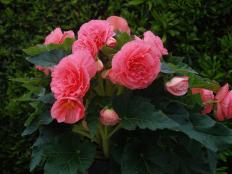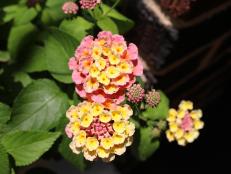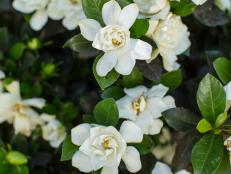Propagating Begonias


Birds do it, bees do it, and even begonias do it—they make babies. One way begonias make babies is with a little help from gardeners like us.
You can grow begonias from seed, but it’s much easier to propagate them from cuttings instead, and you can do this with most kinds of begonias.
To make babies from cuttings, start by snipping a few healthy leaves from your favorite begonia. Turn the leaves upside down, and slice them into wedges with a sharp, clean knife. (If you use a razor blade, be very careful!) Make sure you get a vein in each piece. You can get a lot of baby plants with this method.
If you’re only interested in getting a few new plants, you don’t have to bother with slicing the leaves. In that case, just remove some leaves from the parent plant, leaving ½” to 1” of the petiole attached to each leaf (the petiole is the stalk that holds the leaf to the stem of the plant).
To make a “nursery” for your leaves or cuttings, fill a tray with well-draining, sterile potting mix. You can use a mixture of perlite, vermiculite and peat moss, if you prefer. Stick the leaf petioles or wedges into the soil, and slip the tray into a plastic bag. Keep it out of direct sunlight, but in a warm, well-lit spot. Mist the soil as needed, so the cuttings stay moist, but don’t keep them so wet that water stands on them. This could invite disease or rot.
You should see roots starting to form in 3 or 4 weeks. In 6 to 8 weeks from the time you started, you’ll have baby plantlets ready to move into the garden or containers.

But making baby begonias can be even easier if you root your cuttings in a glass of clean, fresh water. Baby food jars are the ideal size for this. It’s fine to put several cuttings in each jar. Once the roots are about ½” long, the cuttings are ready to transplant.
Rhizomatous begonias—the kind that are often grown for the their beautiful foliage—will also grow from rhizome cuttings. Rhizomes are the horizontal, thickened stems that grow along or just under the soil.
Simply cut a rhizome into pieces about 1” to 1 ½” long, and press them gently into moistened potting soil, or a moistened mix of perlite and vermiculite. As with the leaf cuttings, give them high humidity and keep them in a warm, well-lit spot out of direct sunlight until roots begin to form.
Growing begonias from their seeds, which are as fine as dust, takes time and careful handling. Remember that if you save the seeds from your hybrid begonias, you won’t get baby plants that look exactly like the parent. That’s because hybrids are created by crossing varieties, so the seeds won’t grow “true.” Sometimes you won’t get any baby plants at all, if the hybrid seeds are sterile.
Bringing up baby begonias is fun and rewarding, so enjoy your new plants.













































